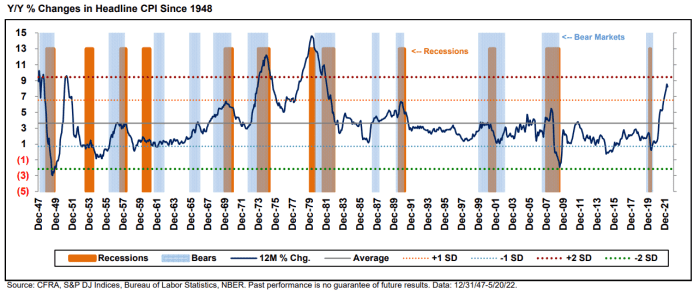This post was originally published on this site
Plenty of investors are convinced U.S. stocks are already in a bear market, even if the benchmark S&P 500 has yet to technically confirm it. History indicates that the ferocity of any decline may depend on whether or not the economy averts a recession.
That sounds obvious, but the debate over whether the economy is headed for recession remains far from settled. So much may still rest on policy decisions and luck.
There’s certainly reason to be nervous. Sam Stovall, chief investment strategist at CFRA, observed in a Monday note that year-over-year increases in inflation that exceed the mean by one standard deviation or more, as is the case now, have been followed by recession.
While that’s no guarantee a recession is in store, the record of bear markets during such downturns might leave investors unsettled, Stovall wrote.

CFRA
“The unnerving historical implication is that every time the Y/Y change in headline CPI exceeded one standard deviation above the mean, the U.S. fell into recession and the S&P 500 suffered through a bear market,” he said (see chart above).
In addition, these bear markets ended up being deeper than those not associated with recessions, falling an average of 38% versus 28%, respectively, Stovall found. Moreover, bears with recessions lasted longer (an average of 15 months) than bears not associated with recessions (average of six months).
A close below 3,837.25 would mark a decline of 20% or more for the S&P 500
SPX,
from its Jan. 3 record finish, meeting the widely used definition of a bear market. If the S&P 500 closes below the threshold, the start of the bear market would be back-dated to the Jan. 3 peak.
The S&P 500 came close recently, trading as low as 3,810.32 on Friday, but it averted the bear as it bounced ahead of the closing bell. The index rose Monday, followed by a 0.8% drop Tuesday to end at 3,941.48. Analysts and investors have argued that the market’s behavior so far in what’s been a brutal 2022 has been in line with past bears.
The Nasdaq Composite
COMP,
entered a bear market earlier this year, while the Dow Jones Industrial Average
DJIA,
has fallen more than 13% from its Jan. 4 record finish.
Stovall noted there have been 12 bear markets since 1948, and an equal number of recessions.
And while most bear markets were typically triggered by impending recessions, not all bear markets were accompanied by one. There were three bear markets —- 1961, 1966 and 1987 —- that occurred independently of recessions, he said, while three U.S. recessions —- 1953, 1960, and 1980 —- weren’t preceded by bear markets.
When stocks did anticipate a recession by slipping into a bear market, peak in prices occurred, on average, seven months ahead of the recession’s start, while only once, in 1990, did a recession and a market peak occur together.
“Encouragingly, while recessions lasted an average of 10 months, bear markets bottomed an average of four months prior to the end of recession,” Stovall said.


